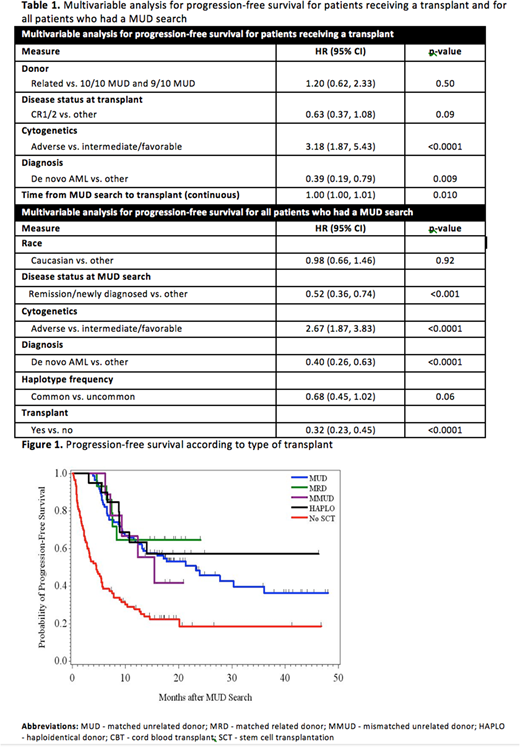Abstract
Introduction
An HLA-matched unrelated donor (MUD) has been accepted as the next best option for patients who do not have a matched-related donor (MRD) available. However, identification of a MUD may be challenging due to donor availability for some populations. In addition, the MUD search and procurement of stem cell product usually takes much longer than that of a related donor, many patients may develop progressive disease or become medically unfit while waiting for a MUD transplant, which might have a negative impact on overall survival.
Therefore, in this study we hypothesized that certain groups of patients may not benefit from performing a MUD search and sought to evaluate availability of a MUD donor, ability to proceed to transplant with a MUD, as well as transplant outcomes for all patients who had a MUD search started at our institution.
Methods
All consecutive patients with a diagnosis of acute myeloid leukemia (AML) and myelodysplastic syndrome (MDS) who had a MUD search performed between 2013 and 2015 were included. All patients had high resolution HLA typing at HLA-A, -B, -C, -DRB1 and -DQB1 performed by DNA sequencing and had unrelated donor search by the NMDP.
According to standard operating procedures, a MUD search was initiated when no MRD was available, or as soon as HLA typing was completed. If no 10/10 MUD was available, the choice between a 9/10 MUD, haploidentical or umbilical cord blood (UCB) was based on the treating physician's decision.
Results
The analysis included 242 patients with a median age of 58 years (range 9-80 years), 123 patients (51%) were male, 182 patients (75%) were Caucasian and 190 (79%) had common haplotypes.
One hundred thirteen patients (47%), 35 (14%), 43 (18%) and 49 (20%) were in complete remission, primary induction failure (PIF), relapse/refractory and newly diagnosed, respectively.
One hundred sixty (66%) patients had a 10/10 MUD identified. The majority of Caucasians (85%) had common haplotypes compared with only 58% of patients with other races (P<0.0001). A 10/10 MUD was found in 141/182 (77%) Caucasian patients, while only 19/60 (32%) non-Caucasian patients had a 10/10 MUD identified (P<0.0001). A significantly higher percentage of patients with common haplotypes had 10/10 MUD identification compared with those of uncommon haplotypes (82% vs. 10%, P<0.0001).
Only 85 of 160 (53%) patients proceeded to MUD transplantation, while 66 (27%) patients received transplants from other donor types [9 (4%) 9/10 MUD, 20 (8%) haploidentical, 22 (9%) UCB and 15 (6%) MRD transplant], and 91 (38%) patients did not receive a transplant. The median time from MUD search to 10/10 MUD, MRD, haploidentical, 9/10 MUD and UCB transplant was 2.9, 2.3, 3.5, 4.6 3.2 months, respectively (P=0.002). Taken together, Caucasian race and having common haplotype were independently associated with 10/10 MUD identification with odds ratio (OR) of 6.8 (95%CI 3.1-14.9) and 39 (95%CI 13.9-110.4), respectively and with proceeding to MUD transplantation (OR 7.7, 95%CI 2.7-21.7 and OR 66, 95%CI 3.9->999), respectively.
A multivariable analysis (MVA) for PFS of patients who received a transplant showed significant impact on transplant outcomes for disease status, cytogenetics and time from a MUD search to transplant, while donor type did not impact transplant PFS (Table 1).
A second MVA for PFS was performed for all patients who had a MUD search. Patients who had intermediate/favorable cytogenetics, de novo AML, newly diagnosed/complete remission and received a transplant experienced significantly better PFS compared with their counterparts (Table 1, Figure 1).
The highest percentages of 10/10 MUD identification, MUD transplant and PFS were observed for Caucasians who were newly diagnosed/complete remission with common haplotype (60% MUD identified, 69% MUD transplant, 3-year PFS rate of 46%), whereas the patient group with the lowest percentages was non-Caucasians with primary induction failure/relapsed/refractory and had uncommon haplotype (1% MUD identified, 0% MUD transplant, 3-year PFS rate of 0%).
Conclusions
Race, haplotype frequency and disease status at the time of MUD search influence probability to identify a MUD and receive a transplant. Patients with low likelihood to receive a MUD transplant may proceed to a haploidentical transplant as soon as indicated, as this approach does not appear to compromise transplant outcomes.
Konopleva:Stemline Therapeutics: Research Funding. Oran:AROG pharmaceuticals: Research Funding; Celgene: Consultancy, Research Funding; ASTEX: Research Funding. Champlin:Otsuka: Research Funding; Sanofi: Research Funding.
Author notes
Asterisk with author names denotes non-ASH members.


